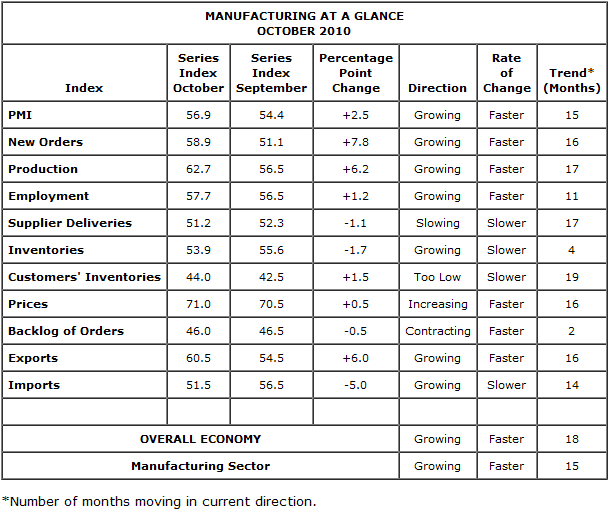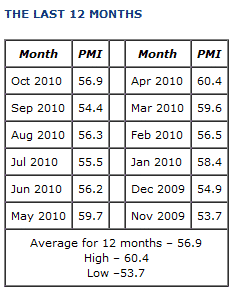ISM Manufacturing Index PMI rises to 56.9%
The Institute for Supply Management (formerly the National Association of Purchasing Management) releases the widely-followed Report On Business® each month. This is considered the most important data set in the manufacturing sector. This morning the latest numbers from the ISM for October 2010 showed a substantial rise from 54.4 to 56.9, putting the manufacturing sector in expansion for the 15th consecutive month.
WHAT RESPONDENTS ARE SAYING …
- "The dollar is weakening again, which is resulting in higher costs for our materials we purchase overseas. It is hurting our profit margins." (Transportation Equipment)
- "Business slowing down but still double digit over last year." (Chemical Products)
- "Currency continues to wreak havoc with commodity pricing." (Food, Beverage & Tobacco Products)
- "Customers remain cautious, placing orders at the last minute, making supply planning a challenge." (Machinery)
- "Our customer base — auto manufacturers — is expanding capacity and making major capital investments." (Fabricated Metal Products)
On the whole, this is a good report. An average PMI above 42 shows an expanding economy. When the reading is above 50, it shows an expanding manufacturing sector. Now, the PMI was strongest during this technical recovery back in the spring:
The summer was very uneven. But the numbers going forward do not need to confirm the earlier strength by posting above 60. For example, in the last cycle, the index peaked out at 61.4 in May 2004 and bounced around the mid-50s for the rest of the cycle until the bottom started to fall out in late 2006. Given the fact that the employment market only turned up at this time in early 2004, it suggests the heart of the last business cycle was only the 2 1/2 years during the housing mania.
But this is not unusual for recent manufacturing cycles as the U.S. has become a service-oriented economy. For example, in the 1990s business cycle, the PMI only peaked at 57.7 in July 1997, spending most of 1995 and 1996 in the 40s after the Fed’s interest rate hikes cooled the economy. The last mid-60s or 70s reading on the PMI was briefly in 1983 when the index peaked at 69.9. And before that we got that high only in 1972 and 1973 before the first oil shock.
So, this is as good as it’s going to get. As far as sub-components go, keep your eye on production which has vaulted up to 62.7 as the inventory story still dominates production (inventories contributed 1.4% to the 2.0% GDP last quarter). The other sub-index to pay attention to is prices. Prices paid are through the roof. The costs have fed through to food prices, but not much else at this point.


Comments are closed.